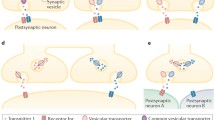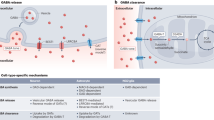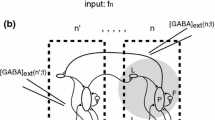Abstract
Alone of the known neurotransmitters, GABA is an electroneutral zwitterion (pI=7.3) at physiological pH. This confers the highest probability of successfully traversing densely packed synaptic gaps without interacting electrostatically with charged entities enroute, making GABA a high fidelity neurotransmitter. Inhibitory tone in the nervous system is coordinately coupled with physiological activity by means of the GABA system, acidification increasing GABA formation and its Cl− channel-opening efficacy, while decreasing its removal by transport and metabolic degradation. The above, together with diminution upon acidification of the postsynaptic efficacy of glutamate on excitatory NMDA receptors constitutes a sensitively responsive mechanism by which protons control levels of neural activity, locally and globally. A model made of the GABA binding site of GABAA receptors based on H-bond and hydrophobic interactions makes it seem unlikely that any other substance known to occur in nerve tissue would give rise to a high noise level at GABAA receptors.
Similar content being viewed by others
References
Roberts, E. 1991. Living systems are tonically inhibited, autonomous optimizers, and disinhibition coupled to variability generation is their major organizing principle: inhibitory command-control at levels of membrane, genome, metabolism, brain, and society. Neurochem Res 16:409–421.
Roberts, E. 1976. Disinhibition of an organizing principle in the nervous system—The role of the GABA system. Application to neurologic and psychiatric disorders. Pages 515–539, in Roberts, E., Chase, T. N., and Tower, D. B. (eds.), GABA in Nervous System Function, Kroc Foundation Series, Vol. 5, Raven Press, New York.
Roberts, E. 1986. GABA: The road to neurotransmitter status. Pages 1–39,in Olsen, R.W. and Venter, J.C. (eds.), Benzodiazepine/GABA Receptors and Chloride Channels: Structural and Functional Properties, Alan R. Liss, Inc., New York.
Roberts, E. 1986. Failure of GABAergic inhibition: A key to local and global seizures. Adv. Neurol. 44:319–341.
Roberts, E. 1986. What do GABA neurons really do? They make possible variability generation in relation to demand. Exp. Neurol. 93:279–290.
Barker, J. L., and Mathers, D. A. 1981. GABA analogues activate channels of different duration on cultured mouse spinal neurons. Science 212:358–361.
Olsen, R. W., and Tobin, A. J. 1990. Molecular biology of GABAA receptors. FASEB J 4:1469–1480.
Wisden, W., Laurie, D. J., Monyer, H., and Seeburg, P. H. 1992. The distribution of 13 GABAA receptor subunit mRNAs in the rat brain. I. Telencephalon, diencephalon, mesencephalon. J. Neurosci. 12:1040–1062.
Laurie, D. J., Seeburg, P. H., and Wisden, W. 1992. The distribution of 13 GABAA receptor subunit mRNAs in the rat brain. II. Olfactory bulb and cerebellum. J. Neurosci. 12:1063–1076.
Burt, D. R., and Kamatchi, G. L. 1991. GABAA receptor subtypes: from pharmacology to molecular biology. FASEB J 5:2916–2923.
Greenstein, J. P., and Winitz, M. 1961. Chemistry of the Amino Acids. Vol. 1, pp. 486–489. John Wiley & Sons, Inc., New York, London.
Vos, J., Kuriyama, K., and Roberts, E. 1968. Electrophoretic mobilities of brain subcellular particles and binding of γ-aminobutyric acid, acetylcholine, norepinephrine, and 5-hydroxytryptamine. Brain Res. 9:224–230.
Sakmann, B. 1992. Elementary steps in synaptic transmission revealed by currents through single ion channels. Neuron 8:613–629.
Bormann, J., Hamill, O. P., and Sakmann, B. 1987. Mechanism of anion permeation through channels gated by glycine and γ-aminobutyric acid in mouse cultured spinal neurones. J. Physiol. 385:243–286.
Traynelis, S. F., and Cull-Candy, S. G. 1990. Proton inhibition of N-methyl-D-aspartate receptors in cerebellar neurons. Nature 345:347–350.
Grinstein, S., and Rothstein, A. 1986. Mechanisms of regulation of the Na+/H+ exchanger. J. Membrane Biol. 90:1–12.
Moolenaar, W. H. 1986. Effects of growth factors on intracellular pH regulation. Ann. Rev. Physiol. 48:363–376.
Roberts, E., and Eidelberg, E. 1960. Metabolic and neurophysiological roles of γ-aminobutyric acid. Int. Rev. Neurobiol. 2:279–332.
Woodbury, D. M. 1980. Antiepileptic drugs: carbonic anhydrase inhibitors. Pages 617–633, in Glaser, G. H., Penry, J. K., and Woodbury, D. M. (eds.), Antiepileptic Drugs: Mechanisms of Action, Raven Press, New York.
White, H. S., Woodbury, D. M., Chen, C. F., Kemp, J. W., Chow, S. Y., and Yen-Chow, Y. C. 1986. Role of glial cation and anion transport mechanisms in etiology and arrest of seizures. Adv. Neurol. 44:695–712.
Schlue, W.-R., and Deitmer, J. W. 1988. Ionic mechanisms of intracellular pH regulation in the nervous system. Ciba Fdn. Symp. 139:47–69.
Erlander, M. G., and Tobin, A. J. 1991. The structural and functional heterogeneity of glutamic acid decarboxylase. A review. Neurochem. Res. 16:215–226.
Wu, J.-Y., Matsuda, T., and Roberts, E. 1973. Purification and characterization of glutamate decarboxylase from mouse brain. J. Biol. Chem. 248:3029–3034.
Schousboe, A., Wu, J.-Y., and Roberts, E. 1973. Purification and characterization of the 4-aminobutyrate-2-ketoglutarate transaminase from mouse brain. Biochemistry 12:2868–2873.
Sano, K., and Roberts, E. 1963. Binding of γ-aminobutyric acid by mouse brain preparations. Biochem. Pharmacol. 12:489–502.
Roberts, E., Liron, Z., Wong, E., and Schroeder, F. 1985. Roles of proton removal and membrane fluidity in Na+- and Cl−-dependent uptake of γ-aminobutyric acid by mouse brain particles. Exp. Neurol. 88:13–26.
Liron, Z., Wong, E., and Roberts, E. 1988. Studies on uptake of γ-aminobutyric acid by mouse brain particles; toward the development of a model. Brain Res. 444:119–132.
Takeuchi, A., and Takeuchi, N. 1967. Anion permeability of the inhibitory post-synaptic membrane of the crayfish neuromuscular junction. J. Physiol. 191:575–590.
Perutz, M.F. 1978. Hemoglobin structure and respiratory transport. Sci. Am. 239:92–125.
Martinez-Carrion, M. 1967. Evidence of a critical histidine residue in soluble aspartic aminotransferase. J. Biol. Chem. 242:1426–1430.
Westhead, E. W. 1965. Photooxidation with rose bengal of a critical histidine residue in yeast enolase. Biochemistry 4:2139–2144.
Melchior, Jr., W. B., and Fahrney, D. 1970. Ethoxyformylation of proteins. Reaction of ethoxyformic anhydride with α-chymotrypsin, pepsin, and pancreatic ribonuclease at pH 4. Biochemistry 9:251–258.
Volwerk, J. J., Pieterson, W. A., and de Haas, G. H. 1974. Histidine at the active site of phospholipase A2. Biochemistry 13:1446–1454.
Martinez-Carrion, M., Kuczenski, R., Tiemeier, D. C., and Peterson, D. L. 1970. The structure and enzyme-coenzyme relationship of supernatant aspartate transaminase after dye sensitized photooxidation. J. Biol. Chem. 245:799–805.
Harmsen, B. J. M., De Bruin, S. H., Janssen, L. H. M., Rodrigues De Miranada, J. F., and Van Os, G. A. J. 1971. pK change of imidazole groups in bovine serum albumin due to the conformational change at neutral pH. Biochemistry 10:3217–3221.
Padan, E., Sarkar, H. K., Viitanen, P. V., Poonian, M. S., and Kaback, H. R. 1985. Site-specific mutagenesis of histidine residues in the lac permease ofEscherichia coli. Proc. Natl. Acad. Sci. USA 82:6765–6768.
Wieland, H. A., Luddens, H., and Seeburg, P. H. 1992. A single histidine in GABAA receptors is essential for benzodiazepine agonist binding. J. Biol. Chem. 267:1426–1429.
Smart, T. G., Moss, S. J., Xie, X., and Huganir, R. L. 1991. GABAA receptors are differentially sensitive to zinc: dependence on subunit composition. Br. J. Pharmacol. 103:1837–1839.
Draguhn, A., Verdorn, T. A., Ewert, M., Seeburg, P. H., and Sakmann, B. 1990. Functional and molecular distinction between recombinant rat GABAA receptor subtypes by Zn2+. Neuron 5:781–788.
Quiocho, F. A. 1990. Atomic structures of periplasmic binding proteins and the high-affinity active transport systems in bacteria. Phil. Trans. R. Soc. Lond. B 326:341–351.
Krause, D. N., Ikeda, K., and Roberts, E. 1981. Dose-conductance relationships for GABA agonists and the effect of uptake inhibitors in crayfish stretch receptor neurons. Brain Res. 225:319–332.
Roberts, E., Krause, D. N., Wong, E., and Mori, A. 1981. Different efficacies of d- and l-γ-amino-β-hydroxybutyric acids in GABA receptor and transport test systems. J. Neurosci. 1:132–140.
Pooler, G. W., and Steward, E. G. 1987. Structural comparisons between GABA, bicuculline and semi-rigid GABA analogues. J. Mol. Struct. 156:247–253.
Lipkowitz, K. B., Gilardi, R.D. and Aprison, M. H. 1989. Electronic and structural features of gamma-aminobutyric acid (GABA) and four of its direct agonists. J. Mol. Struct. 195:65–77.
Lee, F. S., Chu, Z.-T., Bolger, M. B., and Warshel, A. 1992. Calculations of antibody-antigen interactions: microscopic and semimicroscopic evaluation of the free energies of binding of phosphorylcholine analogs to McPC603. Protein Engineering 5:215–228.
Squires, R. F. and Saederup, E. A review of evidence for GABAergic predominance/glutamatergic deficit as a common etiological factor in both schizophrenia and affective psychoses: more support for a continuum hypothesis of “functional” psychosis. Neurochem. Res. 16:1099–1111.
Mayo, S. L., Olafson, B.D., and Goddard III, W. A. 1990. Dreiding: A generic force field for molecular simulations. J. Phys. Chem. 94:8897–8909.
Author information
Authors and Affiliations
Additional information
Special issue dedicated to Dr. Claude Baxter.
Rights and permissions
About this article
Cite this article
Roberts, E., Sherman, M.A. GABA—The quintessential neurotransmitter: Electroneutrality, fidelity, specificity, and a model for the ligand binding site of GABAA receptors. Neurochem Res 18, 365–376 (1993). https://doi.org/10.1007/BF00967239
Accepted:
Issue Date:
DOI: https://doi.org/10.1007/BF00967239




